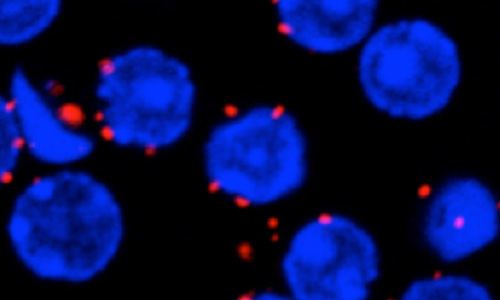How protein islands form

The researchers are using the "Proximity Ligation Assay" method to measure the distances between B cell receptors on the surface of the cell. If it is less than 20 nanometers, it appears in fluorescent red. Photo: Kathrin Kläsener
The immune system protects humans from threats such as, for example, disease-causing bacteria, and cancer as well. Yet if the system malfunctions, it can attack the body it is supposed to defend and cause autoimmune diseases such as type one diabetes mellitus or multiple sclerosis.
The working group of Dr. Susana Minguet, a biochemist – working in cooperation with Prof. Dr. Michael Reth, the chairman of the Department of Molecular Immunology at the University of Freiburg, and Prof. Dr. Miguel Ángel del Pozo of the National Center for Cardiovascular Research Carlos III (“Centro Nacional de Investigationes Cardiovasculares Carlos III” (CNIC)) in Madrid, has demonstrated that the membrane protein Caveolin-1 plays a key role in immune responses that trigger this type of disease. The team has presented its findings in the specialist journal “Nature Immunology.”
Up to now research has often viewed autoimmune disease as the result of immune system hyperactivity, yet recently it has become increasingly clear that such ailments may also result from an immune system those responses are too weak.
This finding, which is supported by the researchers' study, could result in new approaches to treating these diseases. Therapies have until recently been aimed at suppressing patients' immune responses. Now, autoimmune diseases could be treated using alternative strategies, such as gene therapy, for example.
The group has identified the elementary function of Caveolin-1 in the plasma membrane of B-cells, the immune system cells that produce antibodies. B cells recognize substances via B cell antigen receptors (BCR). These protrude from the surface of the cell and, like a type of antenna, ensure that the B cells recognize all sorts of intruders – such as bacteria or viruses.
Once the intruder has been bound by the BCR, the B cell is activated and, together with other immune cells, can fight off a range of different types of pathogens.
Current studies, such as those of Michael Reth, for example, indicate that these antennas are not randomly distributed over the surface of the cell. Instead, they are bundled together in organized protein islands that coalesce as soon as a foreign substance is bound to a B cell receptor.
Minguet and her team have discovered that the protein Caveolin-1 regulates this organization, making it the key to activation of the B cells and the triggering of an immune response. Without Caveolin-1, the binding of viruses or bacteria to the B cell results in a reduced activation signal, which leads to a weakened immune response.
In the body, developing B cells are educated to distinguish the body's own substances from foreign ones. This process is based on the efficient signal transfer of the B cell receptors.
B cells that do not produce Caveolin-1 cannot properly organize the receptor on the cell membrane and as a result, efficient signal transfer fails. It is then that B cells emerge that recognize the body's own tissues. Yet they classify them as foreign, which leads to activation of the B cell and an undesirable immune response which can result in triggering autoimmune disease. The researchers demonstrated this by conducting experiments on mice.
The team's results have the potential to improve the current understanding of autoimmune disease and its treatment – also because up to now, science has lacked suitable animal models that present the same immune deficiencies that are observed in humans.
Susana Minguet began the research project in 2008 at the CNIC in Madrid, Spain. Since 2011, she has been a junior group leader at the Institute of Biology III at the University of Freiburg, where with the support of the Collaborative Research Center 1160 “Immune-mediated pathology as consequence of impaired immune reactions – IMPATH,” she has been continuing her project at the BIOSS Centre for Biological Signalling Studies and the Center for Chronic Immunodeficiency – the CCI.
Original publication:
Caveolin-1-dependent nanoscale organization of the BCR regulates B cell tolerance. Susana Minguet, Kathrin Kläsener, Anna-Maria Schaffer, Gina J Fiala, Teresa Osteso-Ibánez, Katrin Raute, Inmaculada Navarro-Lérida, Frederike A Hartl, Maximilian Seidl, Michael Reth & Miguel A Del Pozo. Nature Immunology, http://dx.doi.org/10.1038/ni.3813.
Contact:
Dr. Gina Fiala
BIOSS Centre for Biological Signalling Studies
University of Freiburg
Phone: +49 (0)761 / 203 – 67512
E-Mail: gina.fiala@biologie.uni-freiburg.de
https://www.pr.uni-freiburg.de/pm-en/2017/how-protein-islands-form?set_language=…
Media Contact
All latest news from the category: Life Sciences and Chemistry
Articles and reports from the Life Sciences and chemistry area deal with applied and basic research into modern biology, chemistry and human medicine.
Valuable information can be found on a range of life sciences fields including bacteriology, biochemistry, bionics, bioinformatics, biophysics, biotechnology, genetics, geobotany, human biology, marine biology, microbiology, molecular biology, cellular biology, zoology, bioinorganic chemistry, microchemistry and environmental chemistry.
Newest articles

First-of-its-kind study uses remote sensing to monitor plastic debris in rivers and lakes
Remote sensing creates a cost-effective solution to monitoring plastic pollution. A first-of-its-kind study from researchers at the University of Minnesota Twin Cities shows how remote sensing can help monitor and…

Laser-based artificial neuron mimics nerve cell functions at lightning speed
With a processing speed a billion times faster than nature, chip-based laser neuron could help advance AI tasks such as pattern recognition and sequence prediction. Researchers have developed a laser-based…

Optimising the processing of plastic waste
Just one look in the yellow bin reveals a colourful jumble of different types of plastic. However, the purer and more uniform plastic waste is, the easier it is to…



